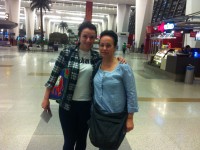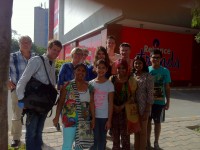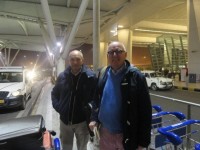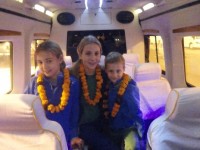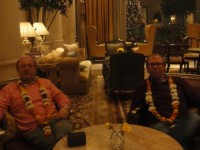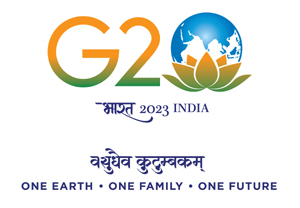
general information
Bangladesh is definitely a surprising country in the South Asia which remains yet to be explored by the travelers. Being a new state in an ancient land, Bangladesh has so many delicate and distinctive attractions of its own to be explored. Bangladesh has a long historical and cultural back ground combining Dravidian, Indo-Aryans, Mongol, Arab, Afgan, Parsian and Turkish.
 Bengal has been a melting pot of ethnic diversity. The unspoiled natural beauty and long cultural heritage, Bangladesh was known to the world, particularly for its muslin, the finest fabric the world has ever produced. Travelers, traders, or scholars from the West and from the Far-East were attracted by the charms and fame of Bangladesh since the time immemorial. All had shown great interest and showered effusive epithets on its bounties and wealth, affluence and prosperity, craftsmanship and cultural advancement. The physical feature of the country is like a painter’s dream come true with rich tapestry of colors and texture. It’s a land of enormous beauty, the vast green crop lands under the boundless blue sky, with so many great river flows down from the high Himalayas and her hundreds of serpentine tributaries and canals formed this fertile land of alluvial soil. The rural people are the power, and be surprised by the challenge of NOBLE Laureate Dr. Muhammad Yunus who changed the life of rural mass by activating the women folk to take active part in Micro Credit program to elevate poverty.
Bengal has been a melting pot of ethnic diversity. The unspoiled natural beauty and long cultural heritage, Bangladesh was known to the world, particularly for its muslin, the finest fabric the world has ever produced. Travelers, traders, or scholars from the West and from the Far-East were attracted by the charms and fame of Bangladesh since the time immemorial. All had shown great interest and showered effusive epithets on its bounties and wealth, affluence and prosperity, craftsmanship and cultural advancement. The physical feature of the country is like a painter’s dream come true with rich tapestry of colors and texture. It’s a land of enormous beauty, the vast green crop lands under the boundless blue sky, with so many great river flows down from the high Himalayas and her hundreds of serpentine tributaries and canals formed this fertile land of alluvial soil. The rural people are the power, and be surprised by the challenge of NOBLE Laureate Dr. Muhammad Yunus who changed the life of rural mass by activating the women folk to take active part in Micro Credit program to elevate poverty.
The crystal clear water lakes surrounded by ever green forested hills, luxuriant tropical rain forests with rich wild life, beautiful cascades of green tea gardens, world’s largest mangrove forest Sundarbans which is the home of the Royal Bengal Tiger , world’s longest natural Sea Beach of Cox’s Bazar, the most distinctive cultural heritage, the exciting archaeological wonder with the biggest Budhist Vihara at Paharpur and the ancient Buddhist civilization at Mahasthangarh of the 4th century BC and the colorful tribal people with their aboriginal living pattern, all are the most potential ingredients to create an unforgettable impression of a land of peace and tranquility. This may be the prime reason why Bangladesh has seldom been highlighted in the tourist maps as one of the top ten tourist destinations of the world. The people mostly belong to four major religions like Islam, Hinduism, Christianity and Buddhism but they tempered with the subtle nature and lush green surroundings into a Bengali character transcending religious differences.Any visitor will appreciate our culture and the environment. These are not simply sight-seeing excursions, but real-time learning experiences. Enjoy the ideal blend of adventure and exploration with comfort and relaxation. This hospitable nation and the millions smiles will never leave you alone. We proudly share our traditions, culture and the warmth hospitality of our people.
GEOGRAPHY
Bangladesh has an area of approximately 147,540 square kilometer in the south Asian region. The country is surrounded by India completely in the West, North, and partially in the East sharing a total of 4,053 kilometer border, while the rest 193 kilometer of the Eastern side is bordered by Myanmar. The Bay of Bengal retains its boundary In the South, where we have a 580 kilometer of coastline.
About half the total area is actively deltaic and never higher than 10m from mean sea level. This flat low lying land is very fertile and is suitable for rice cultivation. The vast river delta area is home to the dominant plains culture. In the northeast and the southeast the land is more hilly and dry, and tea is grown. The hilly areas of the northeast and southeast are occupied by much smaller tribal groups.
Ganges and Brahmaputra are the two main rivers of Bangladesh, carrying tones of silts from the mighty Himalayans that eventually fertile the plain. Apart from these two rivers, we have hundreds of others comprising a very wide and complex river system.
Sundarbans, the largest mangrove forest of the world, is situated in the southwest. The Chittagong Hill Tracts have extensive hardwood forests. Lawachara is a semi-evergreen forest situated in the northeast in Sri Mangal. The Sal forest is spread around in various parts of the country, like Bhawal and Modhupur National Park.
CLIMATE
Bangladesh has tropical monsoon climate characterized by wide seasonal variations in rainfall, high temperatures, and high humidity. Regional climatic differences in this flat country are minor. Three seasons are generally recognized: a hot, muggy summer from March to June; a hot, humid and rainy monsoon season from June to November; and a warm-hot, dry winter from December to February. In general, maximum summer temperatures range between 38 and 41 °C (100.4 and 105.8 °F). April is the hottest month in most parts of the country. January is the coolest (but still hot) month, when the average temperature for most of the country is 16–20 °C (61–68 °F) during the day and around 10 °C (50 °F) at night.
Winds are mostly from the north and northwest in the winter, blowing gently over the country. From March to May, violent thunderstorms, called northwesters, produce winds of up to 60 kilometers per hour (37.3 mph). Heavy rainfall is chart.
FESTIVAL & CULTURE
Bangladesh is a land of festivity. Muslims celebrate Eid-ul-Fitr, Eid-ul-Azha, Eid-e-Miladunnabi, Muharram etc. Hindus observe Durga Puja, Kali Puja, and Sarashwati Puja among others. Buddha Purnima is the biggest festival for Bangali Buddhists, and Borodin (Christmas) is celebrated by the Christians. People from several tribal communities also have their respective festival as well.
Apart from these religious and tribal celebrations we also have several secular festivals. Pohela Boishakh (Bangla New Year) is the biggest among all the festivals in Bangladesh. This day People get into their best attires, go out with friends or family, business men open their new book of records and send sweets & fruits to their regular clients, cultural organizations organize cultural programmes, students bring morning processions called Probhat Ferry. Nobanno (New Rice) is another of our festivals, which is strongly based in the rural Bangladesh. When the farmers get new rice, they observe this day with Rice flour and sugar mixed in water and Puffed rice.
We also observe 21st February as Shahid Dibash (as observed worldwide as International Mother Language Day), 26th March as Independence Day, and 16th December as Victory Day.
Rice is our staple food. In general we eat steam boiled rice with vegetables and fish or meat. We cook Polau rice, Biriani or fried rice in celebrating special occasions. Puffed and popped rice are common especially in villages, where a guest is entertained with puffed rice and a piece of Gurh (a replacement of sugar made by boiling date palm sap).
Women usually wear Sari, but younger ladies wear Salwar Kamij. Jewelry of gold and silver is very popular among ladies of all ages. Ladies keep long hair. A special twisted bun, called Beni, is popular a hair style among young girls, while ladies prefer Khopa (kind of tying the hair mass at the back of head) in general. Males casually wear Lungi or Pajamas with or without under shirt, Panjabi or Fatua. In formal occasions or in offices men wear western shirt and pants. In general, people love to wear colourful dresses.
People in Bangladesh are still family oriented. We either live together as an extended family or frequently visit our parents and relatives in vacations and weekends. Respecting elders is a norm here. In every major occasion of our lives we have our parents and relatives playing a major role. Arranged marriage is still a common sight, even when people chose their partner they proceed through their respective families to arrange the wedding.
LITERATURE
The era of modern Bengali literature matured in the nineteenth century. Rabindranath Tagore, Nobel Laureate is a vital part of Bengali culture. Kazi Nazrul Islam, Michael Madhusudan Datta, Sharat Chandra Chattapadhaya, Bankim Chandra Chattapadhaya, Mir Mosharraf Hossain and Kazi Ahdul Wadud are the pioneers of modern Bengali literature. Bangladesh also has a long tradition in folk literature, evidenced by Maimansingha Githika, Thakurmar Jhuli and stories related to Gopal Bhar.
MUSIC
Traditional music in Bangladesh shares the perspectives of that of the Indian sub-continent. Music in Bangladesh can be divided into three distinct categories -classical, folk and modern. Ustad Alauddin Khan and Ustad Ayet Ali Khan are two names in classical instrumental music who are internationally recognized.
The store of folk song abounds in spiritual lyrics of Lalan Shah, Hasan Raja, Romesh Shill and many anonymous lyricists. Bangla music arena is enriched with Jari, Shari, Bhatiali, Murshidi and other types of folk songs. Rabindra Sangeet and Nazrul Sangeet are our precious heritage. Modern music is also practiced widely. Contemporary patterns have more inclinations to west. Pop song and band groups are also coming up mainly in big cities.
Bangladesh has a good number of musical instruments of her own. Original musical instruments include Banshi (bamboo flute), Dhole (wooden drums), Ektara (a single stringed instrument), Dotara (a two stringed instrument), Mandira (a pair of metal bawls used as rhythm instrument), Khanjani, Sharinda etc. Now-a-days western instruments such as Guitar, Drums, Saxophone, and Synthesizer etc. are being used alongside country instruments.
PAINTING
Bangladesh has a rich tradition of modern painting which was pioneered by Zainul Abedin, Kamrul Hassan, Anwarul Haque, Shafiuddin Ahmed and S.M. Sultan. Zainul Abedin earned international fame for his sketches on famine of 1943 in Bangladesh. Other famous artists of Bangladesh are Abdur Razzak, Qayum Chowdhury, Murtaza Bashir, Aminul Islam, Debdas Chakraborti, Kazi Abdul Baset, Syed Jahangir, and Mohammad Kibria.
DANCE
Classical forms of the sub-continent predominate in Bangladeshi dance. The folk, tribal and Middle Eastern traits are also common. Among the tribal dances, particularly popular are Monipuri and Santal. Rural girls are in the habit of dancing that does not require any grammar or regulations. Bangla songs like jari and shari are presented accompanied with dance of both male and female performers.
JATRA
Jatra (Folk Drama) is another vital chapter of Bangalee culture. It depicts mythological episodes of love and tragedy. Legendary plays of heroism are also popular, particularly in the rural areas. In near past jatra was the biggest entertainment means for the rural Bangalees. Gradually western culture is occupying the place of traditional culture like jatra.
ECONOMY
Bangladesh has made significant strides in its economic sectors since independence in 1971. The country is in 46th position among 193 countries with a gross domestic product of US$ 242,200 million. The economy has grown at the rate of 6-7% annually over the past few years. More than half of the GDP belongs to the service sector that employs 25% of the work force, while half of the work force is employed in the agricultural sector that counts for 18% of our GDP.
With sound planning and forward vision of the regulatory body as well as the Government, Bangladesh proved to be resilient to the latest global meltdown. Rather it showed a very healthy and steady growth of its GDP during last few years and is predicted to have similar trend in the coming years, while most of the developed and developing countries of the world are experiencing either gridlock or backward move of their GDP.
Micro Credit, initiated by Nobel Laureate Dr. Md. Yunus, is being implemented by NGOs and local banks. This was a leap forward for the country in terms of rural development as well as women empowerment. This also helped Bangladesh achieve very low rate of unemployment, which is only 2.50%. Despite regular natural calamities and frequent political instabilities over the years, Bangladesh has set an example for the world in keeping constant economic development through industrialization in an open market policy without shifting its concentration from Agricultural base and maintaining a low disparity between rich and poor (GINI ratio 33.2).
DEMOGRAPHY
The majority of the population (98 percent) is Bengali, with 2 percent belonging to tribal or other non-Bengali groups. Approximately 88 percent of the population is Muslim, 10 percent is Hindu, and 2 percent is Buddhist, Christian and people from various tribal groups. Majority of the Muslim community are Sunni, while some Shias, Ahmadiyas and Sufis also live in Bangladesh.
Bangladesh has an approximate population density of 1,084 per square kilometer (2,808 per square mile). Annual population growth rate is at about 1.30 percent. Infant mortality is approximately fifty nine per one thousand live births. Life expectancy at birth for both men and women is 60 years, yet the sex ratios for cohorts above sixty years of age are skewed toward females.
Primary enrollment rate being very high, 97%, with very satisfactory performance of schooling throughout the country, adult literacy rate (53%) is expected to increase to a good height soon. Among primary and high schools 53% are girls and 47% are boys.
Approximately 75% of the people live in the rural areas of Bangladesh. By and large the country is agro based that generates more than 45% of country’s employment. About 35% out of total population is aged below 15, while 61% are aged between 15 and 64 years indicating that majority of its population is young.
DRESS
Bangladeshi people have distinctive dress preferences. Bangladeshi men wear panjabi on religious and cultural occasions, lungi as casual wear and shirt-pant on formal occasions. Sari is the main dress of women. Sari weaving is a traditional art in Bangladesh. Salwar Kameez, a three piece costume, is popular especially among the younger ladies.
CURRENCY
The name of Bangladeshi currency is the Taka (BDT). Notes are available in denominations of 2, 5, 10, 50, 100, 500 and 1000 Taka; coins of 50 Paisa and 1, 2 and 5 Taka are available. 100 Paisa equals 1 Taka.
Bangladesh visa information
Citizens from the following countries can get a visa on arrival at an international airport in Bangladesh:
Australia, Austria, Belgium, Brunei, Canada, China, Cyprus, Denmark, Egypt, France, German, Iceland, Italy, Ireland, Japan, Kuwait, Luxemburg, Malaysia, Netherlands, New Zealand, Norway, Oman, Portugal, Qatar, Russia, Singapore, Saudi Arabia, South Korea, Spain, Sweden, Turkey, United Kingdom, United Arab Emirate, USA, and East European countries.
Visa Fees:
Visa on arrival: $50
Transit Visa: $20
Please see table below for more details on visa fees for individual countries
Applicable to: Tourists and business travelers
Port of Entry for visa on-arrival and transit visas:
Only at the international airports in Dhaka and Chittagong.
Visa on-arrival is not issued at any of the land borders of Bangladesh with her neighboring countries.
It may be noted that for such a visa or permit, the port of entry and port of departure should be the same.
Documents needed to be eligible for a visa on arrival:
A return air ticket or a printout of the e-tickets with details of the return itinerary from Bangladesh
At least US$500
Business travellers need to show necessary papers to the Immigration officer to prove that they have come to visit Bangladesh for business purpose
An invitation letter from an organization or a travel company for tourists
Validity of Visas:
On-arrival visas are issued for 30 days
Transit visas are issued for 72 hours
Visa Requirements:
Visa Type
Requirements
Tourist Visa
Travel itinerary/air ticket reservation.
Work visa:
Letter of employment from the employer in Bangladesh and letter of concurrence from concerned Ministry, Board of Investment (BOI), Bangladesh Export Processing Zone (BEPZA). To work in a non-governmental organization (NGO), the applicant should furnish copy of letter of appointment from the NGO with attestation by the Bangladesh NGO Affairs Bureau, Dhaka.
Student visa:
Letter from the concerned educational institution duly attested by the Bangladesh Ministry of Education, Dhaka and Certificate of financial guarantee
Business visa
Letter from the employer in the United States and invitation letter from the host company in Bangladesh clearly stating the purpose of the visit. If you are interested to include your name in the list of interested importers from Bangladesh, please click here.


